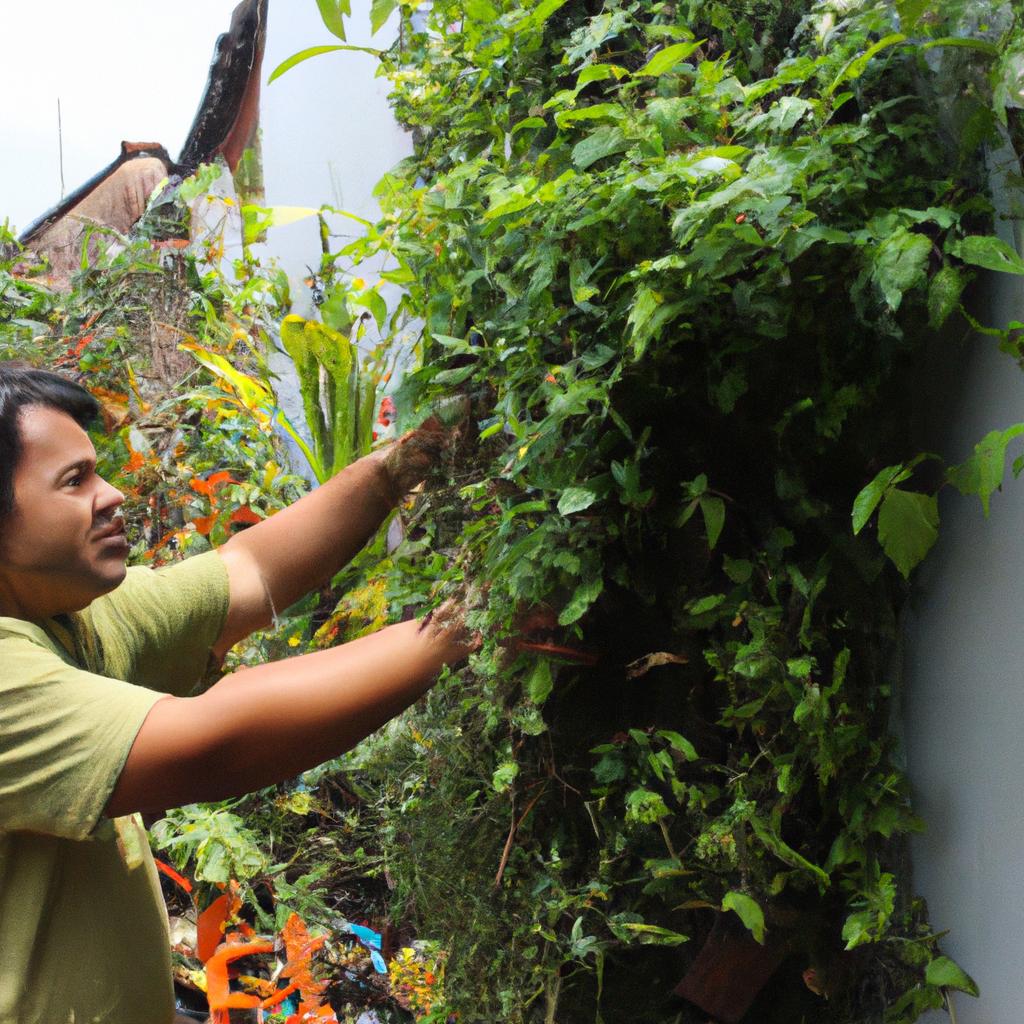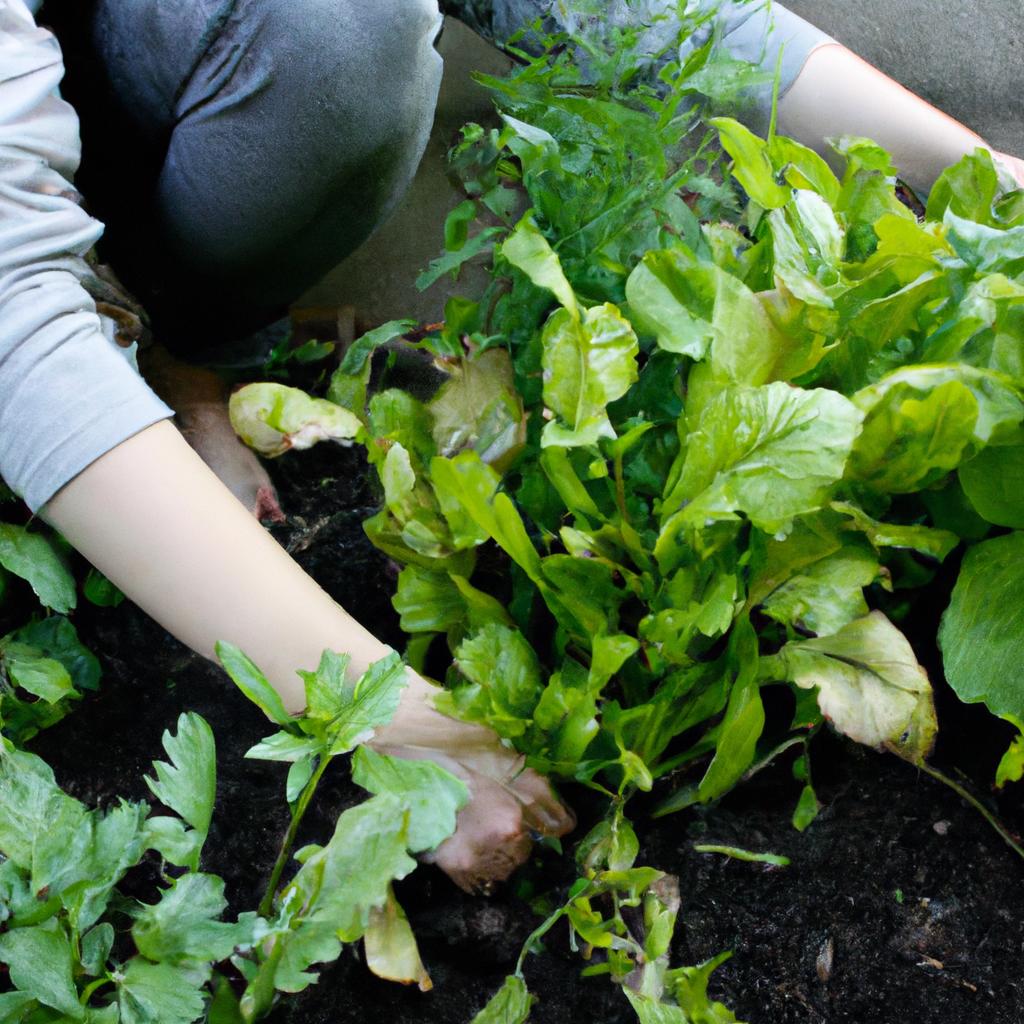Composting techniques play a vital role in enhancing recreation and food gardening by providing an effective solution for waste management while simultaneously enriching the soil. For instance, imagine a community garden struggling with excessive organic waste from nearby households and lacking nutrient-rich soil to support healthy plant growth. By implementing proper composting techniques, such as aerobic decomposition or vermicomposting, this community garden could transform its waste into valuable compost, which would not only reduce their ecological footprint but also improve the quality of their produce.
In recent years, there has been growing interest in exploring different composting methods to address environmental concerns and promote sustainable practices. Composting offers numerous benefits beyond waste reduction; it can enhance both recreational spaces and food gardens alike. This article aims to delve into various composting techniques that have proven successful in augmenting these areas. Additionally, this study will explore how implementing efficient composting systems contributes to creating vibrant recreational spaces where individuals can reconnect with nature while also promoting healthier food production through improved soil fertility.
Benefits of Composting
Composting, the process of decomposing organic materials to create nutrient-rich soil amendments, offers numerous benefits for both recreation and food gardening. To illustrate its potential impact, consider a hypothetical scenario where a community garden implemented composting techniques. Initially struggling with poor soil quality, the gardeners introduced composting practices and witnessed remarkable improvements in their crops’ health and productivity.
One significant benefit of composting is that it enriches soil fertility. By incorporating organic matter into the soil, compost enhances its structure, moisture retention capacity, and nutrient content. This transformation facilitates better root growth and nutrient absorption by plants, resulting in healthier vegetation overall. For instance, when our hypothetical community garden began using compost as a soil amendment, they noticed increased yields and improved plant vigor across various crop types.
Moreover, composting contributes to waste reduction by diverting organic materials from landfills or incineration sites. According to research conducted by environmental organizations such as Earth911, around 30% of household waste consists of biodegradable material that could be effectively composted instead of being discarded as garbage[^1^]. Diverting this waste stream to produce valuable compost not only reduces landfill congestion but also minimizes methane emissions produced during decomposition in anaerobic conditions.
- Reduces dependence on synthetic fertilizers
- Minimizes water pollution caused by runoff from chemical fertilizers
- Encourages biodiversity in gardens through improved soil health
- Promotes sustainable agriculture practices
To further emphasize the benefits visually, here’s an example table showcasing some key advantages associated with composting:
| Benefit | Description |
|---|---|
| Nutrient enrichment | Enhances soil fertility and promotes healthy plant growth |
| Waste reduction | Diverts organic materials from landfills or incineration sites |
| Environmental awareness | Fosters a sense of responsibility towards the environment |
By composting, individuals can actively contribute to mitigating environmental challenges while enjoying the benefits in their recreational spaces and food gardens. In the subsequent section about “Traditional Composting,” we will explore one popular method widely used for composting at home.
[^1^]: Earth911. (n.d.). 5 Benefits of Composting. Retrieved February 16, 2022, from https://earth911.com/home-garden/benefits-of-composting/.Traditional Composting
Enhancing Recreation and Food Gardening through Composting Techniques
To illustrate this further, imagine a scenario where an avid gardener named Sarah decides to implement composting in her backyard garden.
Paragraph 1:
Sarah begins by selecting a suitable location for her compost pile, ensuring it is easily accessible yet hidden from view. She then sets up a three-bin system, which allows her to separate different stages of decomposition and facilitate turning of the materials. By following these steps, she ensures efficient management of organic waste while maintaining a clean and organized gardening space.
Paragraph 2:
To optimize the nutrient content of her compost, Sarah carefully balances green and brown materials. Green materials include grass clippings, food scraps, and fresh plant trimmings, while brown materials consist of dried leaves, sawdust, or shredded paper. This balance provides sufficient nitrogen-rich components for microbial activity along with carbon sources for structural stability within the compost pile.
- Reduces landfill waste by diverting organic matter
- Enhances soil structure and water retention capabilities
- Promotes healthy plant growth through increased nutrient availability
- Minimizes reliance on chemical fertilizers
| Advantages of Traditional Composting |
|---|
| Reduced environmental impact |
| Cost-effective alternative |
| Encourages sustainable practices |
| Supports local agriculture |
Paragraph 3:
Implementing traditional composting techniques not only helps individuals like Sarah reduce their ecological footprint but also contributes to broader environmental conservation efforts. The resulting nutrient-rich humus enhances soil fertility and promotes optimal conditions for plant growth without relying heavily on synthetic fertilizers or harmful chemicals.
With a solid foundation in traditional composting techniques established, our exploration will now shift towards the exciting realm of vermicomposting, a method that employs worms to accelerate decomposition.
Vermicomposting
Enhancing Recreation and Food Gardening through Composting Techniques
Traditional composting has long been practiced as an effective method to recycle organic waste and improve soil fertility. However, there are alternative techniques that can further enhance the benefits of composting. One such technique is vermicomposting, which involves the use of earthworms to break down organic matter into nutrient-rich castings. By exploring this approach, we can uncover new opportunities for optimizing composting practices.
To illustrate the potential of vermicomposting, let us consider a hypothetical scenario: Imagine a community garden struggling with poor soil quality and limited access to fertilizers. The gardeners decide to implement vermicomposting by introducing red worms into their existing compost bins. Over time, these diligent workers diligently convert kitchen scraps and yard waste into dark, crumbly worm castings that are rich in valuable nutrients like nitrogen, phosphorus, and potassium.
The benefits of incorporating vermicomposting extend beyond just improving soil fertility. Here are some key advantages:
- Increased microbial activity: Vermicompost contains beneficial microorganisms that boost plant growth and suppress harmful pathogens.
- Enhanced water retention: The humus-like structure of vermicast improves soil’s water holding capacity, reducing irrigation needs.
- Reduced greenhouse gas emissions: Vermicomposting helps divert organic waste from landfills, where it would otherwise release methane – a potent greenhouse gas.
- Sustainable resource management: By recycling organic materials on-site through vermicomposting, communities reduce their reliance on external resources while minimizing environmental impact.
Table 1 showcases a comparison between traditional composting and vermicomposting techniques:
| Aspect | Traditional Composting | Vermicomposting |
|---|---|---|
| Decomposition Speed | Slower | Faster |
| Nutrient Content | Moderate | High |
| Odor Control | Requires careful management | Minimal odor |
| Space Requirement | Larger area needed | Compact setup |
As we can see, vermicomposting offers several advantages over traditional composting techniques.
Building upon the principles of nutrient recycling through organic waste, let us now delve into the world of Bokashi Composting – a fermentation-based technique that provides an alternative approach to traditional composting practices.
Bokashi Composting
Transitioning from the previous section on Vermicomposting, let us now explore another effective composting technique known as Bokashi Composting. This method originates from Japan and involves fermenting organic waste using a specialized inoculant called bokashi bran. By incorporating this technique into your composting routine, you can significantly enhance both recreational gardening activities and food production.
To illustrate the benefits of Bokashi Composting, consider the example of a community garden in an urban setting. The garden consists of several plots tended by individuals who are passionate about growing their own fruits and vegetables. In an effort to improve soil fertility and reduce waste, the garden committee decides to implement Bokashi Composting. Each gardener is provided with a small countertop bin for collecting kitchen scraps, which they then mix with bokashi bran before burying it within their respective plots. Over time, not only does this result in nutrient-rich soil but also fosters camaraderie among the gardeners as they collectively contribute towards sustainable practices.
Bokashi Composting offers numerous advantages that make it an appealing option for many enthusiasts:
- Versatility: Unlike traditional composting methods that require specific components like leaves or yard trimmings, Bokashi Composting accepts all types of organic waste, including meat, dairy products, and citrus peels.
- Space Efficiency: Due to its anaerobic nature, Bokashi Composting can be carried out indoors or in confined spaces such as apartments or small gardens without causing unpleasant odors.
- Speedy Decomposition: Fermentation occurs rapidly when utilizing bokashi bran, allowing for quicker breakdown of organic matter compared to other composting techniques.
- Nutrient Retention: Bokashi Compost retains higher levels of essential nutrients like nitrogen and phosphorus due to the absence of intense microbial activity during fermentation.
Consider the following table showcasing a comparison between traditional composting and Bokashi Composting:
| Aspect | Traditional Composting | Bokashi Composting |
|---|---|---|
| Acceptable Waste Types | Limited | All types |
| Odor Generation | Possible | Minimal |
| Decomposition Speed | Moderate to slow | Rapid |
| Nutrient Retention | Varies | High |
Transitioning into the subsequent section on Hot Composting, it is worth exploring another composting technique that utilizes heat as a catalyst for decomposition. By harnessing the power of high temperatures, this method can further optimize organic waste breakdown and nutrient availability in your garden.
Hot Composting
Transitioning from the previous section on Bokashi composting, let us now explore another effective technique known as hot composting. To illustrate its practicality, consider a hypothetical scenario where a community garden in an urban setting aims to reduce food waste and improve soil health. By implementing hot composting methods, they can convert their organic kitchen scraps into nutrient-rich compost for their gardening needs.
Hot composting involves utilizing high temperatures generated by microbial activity to accelerate the breakdown of organic matter. This process requires careful attention to achieve optimal conditions for decomposition. Here are some key steps involved in hot composting:
-
Balancing ingredients: A successful hot compost pile consists of a balanced mix of “green” nitrogen-rich materials (such as fruit and vegetable scraps) and “brown” carbon-rich materials (like dried leaves or straw). Achieving the proper ratio is crucial for efficient decomposition.
-
Layering: Building the pile with alternating layers of green and brown materials helps create airflow within the heap, ensuring sufficient oxygen supply for microorganisms. Adequate moisture levels must also be maintained throughout the process.
-
Turning: Regularly turning or aerating the pile promotes even decomposition and prevents unpleasant odors associated with anaerobic conditions. This step allows fresh air to reach different parts of the compost, encouraging beneficial aerobic bacteria growth.
-
Monitoring temperature: Hot compost piles typically reach temperatures between 130-160°F (55-71°C), which eliminates pathogens and weed seeds effectively. Using a thermometer to monitor temperature is essential for adjusting moisture levels and determining when the pile is ready for use.
To further understand the benefits and considerations of hot composting techniques, refer to Table 1 below:
Table 1: Benefits and Considerations of Hot Composting
| Benefits | Considerations |
|---|---|
| Rapid decomposition | Requires regular maintenance |
| Kills weed seeds and pathogens | Requires proper temperature control |
| Produces nutrient-rich compost | May generate foul odors if not managed properly |
| Reduces landfill waste | Needs space for a large compost pile |
In summary, hot composting presents an efficient method for transforming organic waste into valuable resources. By following the necessary steps and maintaining optimal conditions, individuals or communities can create high-quality compost to enrich their gardens while diverting significant amounts of food waste from landfills. Next, we will explore another fascinating technique: composting with worms.
Moving on to the next section about “Composting with Worms,” let’s delve into how these remarkable creatures contribute to sustainable gardening practices without relying solely on heat-induced decomposition methods.
Composting with Worms
Having discussed the process of hot composting in the previous section, let us now delve into another effective technique for composting – composting with worms. This method, also known as vermicomposting, involves using specific species of earthworms to break down organic matter and produce high-quality compost.
Composting with worms offers numerous benefits, both for recreational gardeners and those interested in food gardening. To illustrate its effectiveness, consider this example: Let’s imagine a small urban community that wants to establish a community garden in an underutilized space. By implementing vermicomposting techniques, they can efficiently transform kitchen scraps and yard waste into nutrient-rich soil amendments, providing ample nourishment for their plants while reducing overall waste.
To engage further with the topic of vermicomposting, here are some key points to consider:
- Increased efficiency: Vermicomposting is a highly efficient method compared to traditional composting techniques. The worms used in this process have voracious appetites and excellent digestion capabilities. They consume organic materials quickly and convert them into rich humus at a faster rate than other methods.
- Minimal odor and space requirements: Unlike traditional compost piles which may emit strong odors or require large outdoor spaces, vermicomposting systems are compact and relatively odorless when properly maintained. These systems can be set up indoors or outdoors, making it suitable for individuals living in apartments or homes with limited outdoor areas.
- Nutrient-dense end product: Worm castings produced through vermicomposting are incredibly nutrient-dense due to the breakdown of organic matter by the worms’ digestive system. These castings contain beneficial microorganisms that enhance soil fertility and promote plant growth.
- Educational opportunities: Implementing vermiculture projects not only provides practical benefits but also serves as an educational tool. Schools, community centers, and even households can use these projects to teach children about sustainable practices such as recycling organic waste and understanding the importance of soil health.
To further illustrate these benefits, consider the following table:
| Benefits of Vermicomposting |
|---|
| Increased efficiency |
| Minimal odor and space requirements |
| Nutrient-dense end product |
| Educational opportunities |
In conclusion, vermicomposting is a valuable technique for enhancing recreational and food gardening practices. Its efficient nature, minimal space requirements, nutrient-rich output, and educational potential make it an attractive option for individuals and communities aiming to reduce waste while improving plant growth. By incorporating this method into their composting strategies, gardeners can experience both environmental and horticultural benefits without significant disruption or inconvenience.
 Refoksa
Refoksa



